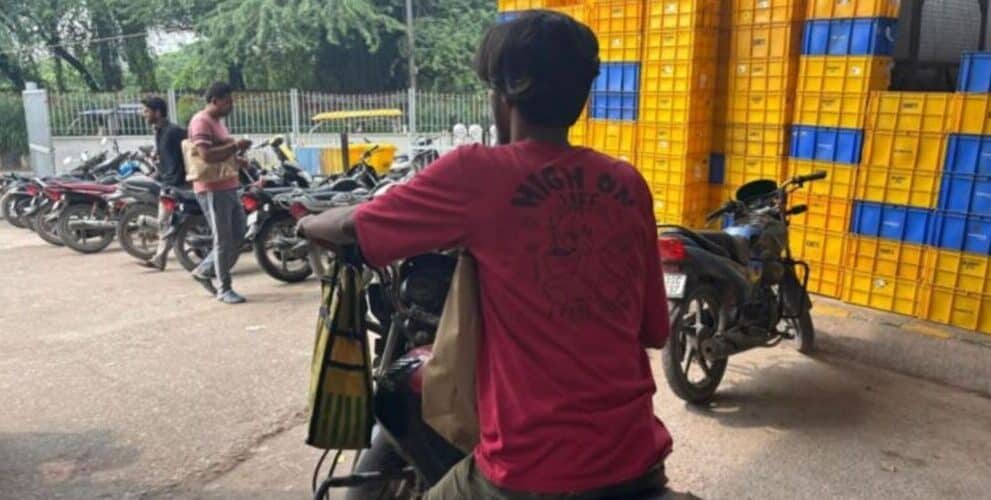Dark side of quick commerce: The untold health struggles of India’s gig workers
Despite the large workforce, gig workers get little to no health benefits or protections. The demands of their jobs also put gig workers at risks of road accidents, weather related illnesses, and other occupational health hazards
Author
Author
- admin / 4 weeks

- 0
- 9 min read

Author
“This summer, I fainted on the road while riding,” he recalls, the memory of exhaustion and heat stroke symptoms still fresh. “Another time, I met with an accident because I was rushing to deliver an order.” The rush, he explains, is not just about keeping customers happy but about chasing incentives. The quicker the delivery, the more money a rider earns. “The company pushes us with incentives. It makes us drive recklessly. I’ve had two accidents because of this,” he says.
One of those accidents left him in the hospital. Treatment was covered under a government policy that ensures emergency care for accident victims, but Ayan points out that the support system of the platform he works for is slow, almost discouraging.
Ayan is one among the lakhs of gig workers in India, working as delivery persons associated with the various food and grocery delivery platforms, and others who fall outside the traditional employee-employer arrangements.
Remember the time when we used to send our siblings to fetch something from the nearby grocery store, or when our mother realised she had forgotten an ingredient while cooking and relied on her child to run and get it? That was how life worked not long ago—small errands and last-minute runs formed part of everyday life. Today, however, with just a click, people like Ayan in yellow, red, orange, or green uniforms arrive at our doorsteps on two-wheelers to deliver everything from food to medicine. This shift in how we access basic items has been enabled by the growing gig economy. According to a NITI Aayog report, the gig workforce in India is expected to grow from around 77 lakh in 2020 to 2.35 crore by 2030.
Despite the large workforce, these people work with little to no health benefits or protections. The demands of their jobs also put gig workers at risks of road accidents, weather related illnesses, and other occupational health hazards.
Who are gig workers and what health benefits do they get?
Gig workers are individuals engaged in short-term, task-based, or flexible employment that falls outside the traditional employer-employee relationship. Unlike salaried employees, they are typically hired on a per-task or per-delivery basis, without the benefits of fixed salaries, paid leave, or retirement funds.
They are most visible in urban India through food delivery executives working with Swiggy and Zomato, ride-hailing drivers associated with Ola and Uber, and e-commerce delivery personnel linked with Blinkit, Amazon and Flipkart. But the gig workforce also extends to other areas, such as household services, logistics, and freelance online tasks.
As these workers do not function within the ambits of traditional employee-employer relationships, many of them do not receive employment benefits including health insurance covers. In the Union Budget 2025–26, Finance Minister Nirmala Sitharaman made an announcement that directly addresses the health security of gig workers. Acknowledging their growing role in India’s digital economy, she stated that the government will arrange for their identity cards, register them on the e-Shram portal, and provide them healthcare under the Pradhan Mantri Jan Arogya Yojana. Their inclusion in social protection schemes, particularly health insurance, is not just relevant but necessary for the sustainable growth of the economy.

Launched in September 2018, Ayushman Bharat – Pradhan Mantri Jan Arogya Yojana (PM-JAY) is the largest health assurance scheme in the world. It was designed to provide health cover of up to five lakh rupees per family per year for secondary and tertiary care hospitalisation. Unlike earlier fragmented schemes where the annual cover ranged between thirty thousand to three lakh rupees depending on the state, PM-JAY created a uniform, comprehensive, and higher coverage system.
The scheme is fully funded by the government, with implementation costs shared between the Centre and the states. It operates on a cashless and paperless model, ensuring that beneficiaries can walk into any empanelled public or private hospital across the country and access healthcare without out-of-pocket expenses. Importantly, there are no restrictions on family size, age, or gender, and all pre-existing conditions are covered from the very first day. The scheme also provides for pre-hospitalisation expenses of up to three days and post-hospitalisation care of up to fifteen days, including diagnostics and medicines.
Over the years, PM-JAY has expanded from its initial coverage of 10.74 crore families to 14.74 crore families, benefitting nearly 70 crore individuals. With the inclusion of gig workers in Budget 2025, the scheme is moving closer to the vision outlined in the National Health Policy 2017, which emphasised universal health coverage for all citizens. For gig workers who often lack any kind of safety net, this coverage could be transformative.
However, as per a Lok Sabha answer in August 2025, while gig workers has started registering on the e-Shram portal, “the AB- PMJAY scheme for platform workers has not been launched.”
Precarious working conditions of gig workers taking a toll on their health
Faisal Khan, 22, worked for about 12–13 continuous hours daily with an app based grocery delivery platform for almost a year. His day involved rushing through traffic, lugging heavy bags, filled with items for deliveries, sometimes carrying them up the stairs to higher floors— all for as little as Rs 1,000 a day. However, after working with a platform for more than a year, the uncertainty of gig work became all too real when his ID was abruptly terminated. “Suddenly my ID was blocked without any explanation. I’ve been waiting here for hours, not knowing what to do,” he said, when he met him outside a dark store affiliated with the platform.
The termination came on top of mounting health concerns. About three months ago, Faisal began experiencing medical issues caused by carrying the heavy delivery bag for long hours.
Such occupational safety and health risks, and job uncertainties, are all too common for gig workers. They spend long hours on roads, exposing themselves to fatigue, accidents, theft, harassment, and physical assault. A global ILO survey revealed that 83 per cent of app-based taxi drivers and 89 per cent of delivery workers reported safety concerns related to their work. Women, although fewer in number in this sector, face additional vulnerabilities, including harassment and unsafe working conditions.
For Zaid Khan, another gig worker, the toughest challenge of delivery work comes with the changing seasons. “Summers are the hardest,” he said, describing the long climbs up to customers’ top-floor apartments in Delhi’s heat. “In that kind of weather, it becomes unbearable. Many customers don’t cooperate; they don’t see what we go through.”
The struggle doesn’t end when the rains arrive. During the monsoon, Zaid often rides through areas around Holy Family Hospital, where roads are badly waterlogged. “It’s a nightmare to get through, but no one acknowledges our struggle,” he explains.
The work environment around collection points add another layer of hardship, especially when the weather is harsh. At Jamia Metro station, 60–70 riders gather at a time. Yet, there is only one cooler and a cramped sitting area for about 10–15 people. The rest are left standing in Delhi’s blazing heat or pouring rain.
This pressure to ensure that deliveries are not late means that the delivery riders many a times race against time, putting themselves and other passengers on the road at risk. A 2018 study in the UK found that many gig workers “had damaged their vehicles in a collision at work,” “said that they would break the speed limit to meet time pressures,” “had driven through a red light,” and even “reported struggling to stay awake at the wheel.” the situation is not all that different in India.
In fact, countries like India, where road safety is already a challenge, the occupational risks for delivery workers are even more pronounced, especially when you add the pressure of delivering orders on time. Some estimates even say that “over 70% of gig workers in bike and auto services admitted to breaking traffic rules to meet delivery or ride targets.”
In fact, according to reports that analysed road accident fatalities found that “71.2% of the fatalities have been caused due to speeding” in 2022. This is up from 64.4% in 2018. For gig workers and delivery riders, who are expected to fulfill orders in a set amount of time, speeding, jumping signals, and even breaking other traffic rules may be the only option.
“During waterlogging or when potholes slow us down, we still get calls from managers and even customer care, asking why the delivery is late—as if they don’t understand the reality we face,” Ayan, another one of the delivery riders said, highlighting the pressure of needing to be on time with orders.
In fact, some recent cases that involve casualties of delivery riders, underscore this point. Earlier this year, Praveen Kumar, died in a road crash in Noida on his second day as a delivery agent. Media reports suggest that he was riding on the wrong side of the road when he was mowed down by a bus.
A NITI Aayog report had highlighted the different plights faced by gig workers– from job insecurities, to safety concerns. However, for many the health risks and lack of protections when they face health issues, are the biggest concerns. With many of the workers doing 12-13 hour shifts, for as little as Rs 1,000 a day, any health issue could mean choosing between feeding their families, or paying hospital bills.
Despite repeated announcements from the government about schemes to support gig workers, Ayan says he has never received any real benefits. “Everything stays on paper,” he adds with frustration. The risks, he insists, outweigh the rewards. His family, too, urges him to quit, fearing for his safety. Yet, he continues, driven by the desire to be independent. But his warning to others is stark: “People should think twice before joining these quick-commerce platforms; there is a lot of struggle and very little support.”
Also read: How online food delivery and quick commerce apps are impacting health in India | Explainer










